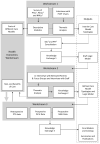End of life care for infants, children and young people (ENHANCE): Protocol for a mixed methods evaluation of current practice in the United Kingdom [version 1; peer review: 2 approved]
- PMID: 35935675
- PMCID: PMC7613236
- DOI: 10.3310/nihropenres.13273.1
End of life care for infants, children and young people (ENHANCE): Protocol for a mixed methods evaluation of current practice in the United Kingdom [version 1; peer review: 2 approved]
Abstract
Background: Although child mortality has decreased over the last few decades, around 4,500 infants and children die in the UK every year, many of whom require palliative care. There is, however, little evidence on paediatric end-of-life care services. The current National Institute for Health and Care Excellence (NICE) guidance provides recommendations about what should be offered, but these are based on low quality evidence. The ENHANCE study aims to identify and investigate the different models of existing end-of-life care provision for infants, children, and young people in the UK, including an assessment of the outcomes and experiences for children and parents, and the cost implications to families and healthcare providers.
Methods: This mixed methods study will use three linked workstreams and a cross-cutting health economics theme to examine end-of-life care models in three exemplar clinical settings: infant, children and young adult cancer services (PTCs), paediatric intensive care units (PICUs), and neonatal units (NNUs).Workstream 1 (WS1) will survey current practice in each setting and will result in an outline of the different models of care used. WS2 is a qualitative comparison of the experiences of staff, parents and patients across the different models identified. WS3 is a quantitative assessment of the outcomes, resource use and costs across the different models identified.
Discussion: Results from this study will contribute to an understanding of how end-of-life care can provide the greatest benefit for children at the end of their lives. It will also allow us to understand the likely benefits of additional funding in end-of-life care in terms of patient outcomes.
Keywords: end-of-life; mixed methods; paediatric; palliative care.
Conflict of interest statement
Competing interests: No competing interests were disclosed.
Figures
Similar articles
-
End of life care in paediatric settings: UK national survey.BMJ Support Palliat Care. 2025 Feb 26;15(2):221-230. doi: 10.1136/spcare-2023-004673. BMJ Support Palliat Care. 2025. PMID: 39609076 Free PMC article.
-
Routine gastric residual volume measurement to guide enteral feeding in mechanically ventilated infants and children: the GASTRIC feasibility study.Health Technol Assess. 2020 May;24(23):1-120. doi: 10.3310/hta24230. Health Technol Assess. 2020. PMID: 32458797 Free PMC article. Clinical Trial.
-
Supporting good quality, community-based end-of-life care for people living with dementia: the SEED research programme including feasibility RCT.Southampton (UK): NIHR Journals Library; 2020 Sep. Southampton (UK): NIHR Journals Library; 2020 Sep. PMID: 33017109 Free Books & Documents. Review.
-
The future of Cochrane Neonatal.Early Hum Dev. 2020 Nov;150:105191. doi: 10.1016/j.earlhumdev.2020.105191. Epub 2020 Sep 12. Early Hum Dev. 2020. PMID: 33036834
-
Evaluation of timeliness and models of transporting critically ill children for intensive care: the DEPICT mixed-methods study [Internet].Southampton (UK): National Institute for Health and Care Research; 2022 Nov. Southampton (UK): National Institute for Health and Care Research; 2022 Nov. PMID: 36469655 Free Books & Documents. Review.
Cited by
-
End of life care in paediatric settings: UK national survey.BMJ Support Palliat Care. 2025 Feb 26;15(2):221-230. doi: 10.1136/spcare-2023-004673. BMJ Support Palliat Care. 2025. PMID: 39609076 Free PMC article.
-
Regional perspectives on the coordination and delivery of paediatric end-of-life care in the UK: a qualitative study.BMC Palliat Care. 2023 Aug 16;22(1):117. doi: 10.1186/s12904-023-01238-w. BMC Palliat Care. 2023. PMID: 37587514 Free PMC article.
-
Healthcare professionals' perspectives of providing end-of-life care for infants, children and young people in acute settings: A multi-site qualitative study.Palliat Med. 2025 Apr;39(4):483-498. doi: 10.1177/02692163251320204. Epub 2025 Feb 24. Palliat Med. 2025. PMID: 39995206 Free PMC article.
-
Parents' experiences of the financial and employment impacts of their child receiving end-of-life care: a national qualitative study.BMC Palliat Care. 2025 Jun 4;24(1):157. doi: 10.1186/s12904-025-01796-1. BMC Palliat Care. 2025. PMID: 40468281 Free PMC article.
References
-
- Office for National Statistics: Mortality statistics-underlying cause, sex and age. London 2019; accessed 27.05.21. Reference Source
-
- NHS: What end of life care involves. 2018; accessed 08/06/21. Reference Source
Grants and funding
LinkOut - more resources
Full Text Sources

